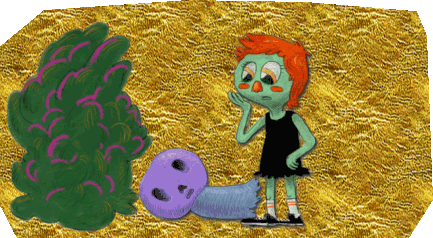
In my lived experience, the locus of meaning, feeling, and action has always been found in the charged intersubjective space between myself and others. In my artistic and teaching practice I am consequently interested in the ways artmaking and imaginative thought encourage one to ‘project’ outward across the chasm which bounds subjective experience.
This interest in intersubjectivity draws from a constellation of thinkers and ideas. Among the most formative are theorists exploring notions of empathy and dialogue; two distinct ideas which nonetheless have a relationship to me. Rudolph Vischer (1873/1994) coined the term ‘einfühlung,’ which later became the English ‘empathy,’ in his treatise On the Optical Sense of Form: A Contribution to Aesthetics. He explicitly linked empathy to the aesthetic experience of form, describing it as a bodily projection onto the observed form/Other, a projection made possible by a “natural love for [one’s] species,” (p. 103) even when directed at an unliving form.
Buber (1947/2002) made a sharp distinction between “the not very significant term ‘empathy’” (p. 114) and true dialogue. His description of empathy as “glid[ing] with one’s own feeling into the dynamic structure of an object [and]…trac[ing] it from within” (p. 115) closely matches Vischer’s description of empathy, which he rightly classified as a one-way projection that excludes the subject’s concreteness. However, Vischer(1873/1994) articulated that empathy “reach[es] out beyond itself and yearns for a reciprocal feeling elsewhere…the harmonious relation between subject and object deepens here into just such a relation between subject and subject” (p. 103). This indicates that while empathetic projection is unidirectional, it is instrumental in forming the I-Thou conception that is the foundation of two-way dialogue.
Neuroscientist Vittorio Gallese (2003) has, through epistemic experimentation, explored the neural mechanisms of empathy, which rest in what have been dubbed “mirror neurons.” These motor neurons activate both when a movement or feeling is experienced, and when it is observed. Gallese linked imitation, empathy, and “mind-reading” (the ascription of motivation and meaning to the behavior of others) to the same “meaningful intersubjective space” (p. 517) produced by the mirror neurons in what he calls the “shared manifold” (p.525). Gallese’s work not only corroborates the affective, precognitive nature of empathetic projection as described by Vischer, but also its somatic, kinesthetic nature, and the functional connection between empathy and more complex forms of place-taking, or “mind-reading.”
Bakhtin (1963/1984) refines the notion of dialogue as presented by Buber, and in his literary criticism finds a way to explicitly relate it to an artform, linking ethics and aesthetics in a way I find extremely useful. His notions of unfinalizability, polyphony, and genre (1976/1986) illuminate dimensions of dialogue undefined by Buber’s more ontological and phenomenological writing, and articulate more concretely how art and life can produce dialogic understanding.
There are also theories of social learning that echo ideas of intersubjectivity. Lev Vygotsky’s (1978) Social Constructivist model of education reflects a cyclic dialogue between teacher and student wherein the student’s ability defines a proximal zone of development, beyond which the teacher helps them navigate, defining a new proximal zone of development in turn. In Lacanian psychoanalysis, identification with the other (as well as one’s own mirror-image) is instrumental in identity-formation (Lacan, 1992). This imaginary formation of the ideal-ego is catalyzed in the mirror stage (Lacan, 1937/2007) during a pre-symbolic period of infancy, which reflects Vischer’s (1873/1994) and Gallese’s (2003) theoretical and scientific observations of empathy as a pre-cognitive, affective, and bodily process. The link between this nascent intersubjective process and a time of life which is steeped in the “presymbolic real” (jagodzinski, 2010) may be why, in my personal lived experience, the space of dialogue has been the locus of (something like) numinous experience, and why this area attracts me personally.
Rene Girard’s (1987) theory of mimesis places “interdividual psychology” (p. 283) at the root of human learning, but adds a shade of complexity that tempers a uniformly positive attitude toward social learning that could lead to naïve or ill-prepared pedagogy. While people acquire knowledge efficiently through observation, imitation, and place-taking, they also acquire values and desires from others, and when the object of a model’s desire becomes the object of one’s own desire, that model becomes a rival. This is perhaps most obvious in the preschool classroom when a unique toy acquires an aura of desirability that precipitates throughout the group, resulting in conflict. This is also visible in the “rivalry” present between a traditional instructor and a particularly adept student, whose modeling of the instructor results in monopolizing class discussion, or correction of the teacher, and threatens the teacher’s desired position of authority as the voice of truth in the classroom. Restrictive social, educational, and disciplinary models intend to curb such emergent conflict, but as I consider such monologic models undesirable and harmful, I must be mindful of the challenges my preferred dialogic classroom may present.
Bakhtin’s notion of the carnivalesque (1965/1984) describes an open space where prescriptive sources of power which impede dialogue are muted or mocked. While the scope of my pedagogical vision focuses on the immediate and the immanent, the present interpersonal interactions from which meaning erupts, I am aware of the need for broader social criticism to preserve the atmosphere of unreserve where such dialogue can take place. Critical theorists such as Marx (1848/2009) and various post- and pseudo- Marxists such as Bloch (1959/1996), Žižek (2010), Deleuze and Guattari (2004), and Freire (1968/2000) afford me a wariness of inhibiting structures, whether imposed from without, or crystallizing within, my classroom, and provide strategies for dismantling such structures to preserve an atmosphere of dialogue.
I place my artistic and pedagogical practice within the overlapping space of these conceptual domains. I observe a cycle in which artmaking and learning as dialogical meaning making precede, follow, and feed into each other.
Efland (2004) noted that artmaking consciously develops as “an object of inquiry” (p. 769) the otherwise unconscious mechanisms behind metaphoric projection of affective kinesthetic subjective experience. Likewise, the intuitive bodily projection of aesthetic empathy onto forms (Vischer, 1873/1994) can be consciously fostered through artmaking (Jeffers, 2009a).
This conscious training of the mind to project outward aesthetically also promotes aninterpersonal empathetic projection. Vischer (1873/1994) explicitly linked these two types of empathic projection. An analogy may be drawn between imaginative artmaking and imaginativeplay, which, Vygotsky (1978) noted, both fosters conscious development of abstract and symbolic thought (e.g. the “stick” is a “horse”) and conscious development of social scaffolding (e.g. two sisters playing at being “sisters,” making conspicuous their previously unacknowledged interdividual relationship). Artmaking also fosters this interpersonal dimension of empathy because it implies an audience (Buber, 1947/2002), and thus can elicit kinesthetic (Gallese, 2003) and emotional (Vischer, 1873/1994) empathy in people other than the artist.
This empathy generates the subject-to-subject relation (Vischer, 1873/1994) that necessarily precedes dialogue. Gallese’s (2003) notion of the “shared manifold” produced by mirror neurons specifies that their empathetic processes generate a “mutual intelligibility”(p. 525), rather than identity, preserving the otherness between the subject and object. This dialogic “sphere of between” (Buber, 1947/2002, p.241) is where real teaching and real learning take place.
Buber (1947/2002) provides a description of a dialogic drawing class, which reflects neither rigid authority nor unsatisfying aimlessness. Instead, the child explores freely, encountering “the delicate, almost imperceptible and yet important influence” (p.105) of criticism and instruction, in which the student is introduced to a scale of values that is not academic or authoritative, but subjective. “The more unacademic this scale of values, and the more individualistic this knowledge, the more deeply do the children experience the encounter” (p.105). This reflects Bakhtin’s (1976/1986) notion of dialogic meaning-making, in which individual voices (the primary genres) have more immediacy and impact than voices refined and compiled in formal texts (secondary genres), and in which the meeting of various voices produces more meaning than the dominance of a single, authoritative voice does. The immanent voice of the teacher takes the place of the transcendent voice of the institution or curriculum.
“[A]ll art is from its origin essentially of the nature of dialogue” (Buber, 1947/2002, p.30), and consequently benefits, in turn, from the cultivation of dialogic learning and thinking. This includes artforms that don’t overtly embody communication between the artist and audience. Bakhtin’s (1963/1984) exploration of Dostoevsky’s writing demonstrated that when authorial voice recedes, a work can contain a polyphonic dialogue within itself. Consequently, a piece can still have a dialogic character, even within the post-modern conception of the “death of the author” (Barthes, 1977). Pursuing empathy and dialogue in art does not preclude contemporary or conceptual artwork, even that which pointedly omits the artist’s voice. Likewise, empathy can inform modern or abstract work where formal concerns supersede concern with content. The ability to bodily project into a form, and the consequent kinesthetic sensations one may feel from that form (Vischer, 1873/1994) can lead to a more considered and effective use of form in an abstract piece. Also, dialogue in the form of criticism, as illustrated in Buber’s example above, can inform artistic development. The back-and-forth between practice and criticism continually produces scaffolding that allows practice to progress and grow, much how interaction with a teacher helps a student grow beyond her/his “zone of proximal development” (Vygotsky, 1978).
Deconstruction and criticism of totalizing forces which threaten the atmosphere of unreserved expression help ensure that dialogue can be preserved and cultivated. For instance, by articulating the concepts of rhizomal and arboreal systems, Deleuze and Guattari (2004) make such systems salient, and the symptoms of hierarchical teaching institutions identifiable and combatable. The Marxist pop-cultural, political, and religious critique of Slavoj Žižek (2003, 2010) inserts another voice into these monophonic entities, opening them up into spaces for interpretation and exploration. Critique of pop-culture is particularly relevant for the art educator, as it is in art class that students may use the tools of pop-culture to create their own visual culture, exercising ownership over the means of production (Marx 1848, 2009) of culture.
References
Bakhtin, M. M. (1984). From Rabelais and his world (H. lswolsky, Trans.). In P. Morris (Ed.), The Bakhtin reader (pp. 195-244). New York, NY: Oxford University Press. (Original work published 1965).
Bakhtin, M. M. (1984). Problems of Dostoevsky’s poetics. (C. Emerson, Trans.). Minneapolis, MN: University of Minnesota Press. (Original work published in 1963).
Bakhtin, M. M. (1986). From speech genres and other late essays (H. lswolsky, Trans.). In P. Morris (Ed.), The Bakhtin reader (pp. 81-87). New York, NY: Oxford University Press. (Original work published 1976).
Barthes, R. (1977). Image, music, text. (S Heath, Trans.). London, United Kingdom: Fontana.
Bloch, E. (1996). The principle of hope. (N. Plaice, S. Plaice, & P. Knight, Trans.). Cambridge, MA: MIT Press. (Original work published 1959).
Buber, M. (2002). Between man and man. (R.G. Smith, Trans.). New York, NY: Routledge. (Original work published 1947).
Deleuze, G., & Guattari, F. (2004). A thousand plateaus, capitalism and schizophrenia. (B. Massumi, Trans.). New York, NY: Continuum Intl Pub Group.
Efland, A. (2004). Art education as imaginative cognition. In E. W. Eisner & M. D. Day (Eds.), Handbook of research and policy in art education (pp. 751-773). Mahwah, NJ: Lawrence Erlbaum and the National Art Education Association.
Freire, P. (2000). Pedagogy of the oppressed. (M. B. Ramos, Trans.). New York, NY: Continuum. (Original work published 1968).
Girard, R. (1987). Things hidden since the foundation of the world. (S. Baan & M. Meteer, Trans.). Palo, Alto, CA: Stanford University Press.
jagodzinski, j. (2010). The site/sight/cite of Jacques Lacan or forget Slavoj Žižek? implications for art and its education. Visual Arts Research, 36(2), 15-37. Retrieved from http://www.jstor.org.proxy.library.vcu.edu/stable/pdfplus/10.5406/visuartsrese.36.2.0015.pdf
Lacan, J. (1992). Homeostasis and insistence. (S. Tomaselli, Trans.). In J. Miller (Ed.), The Seminar of Jacques Lacan Book II: The ego in Freud’s theory and in the technique of psychoanalysis, 1954-1955 (pp. 53-63). New York, NY: W. W. Norton & Company.
Lacan, J. (2007). The mirror stage as formative of the I function. (B. Fink, Trans.). In Écrits (pp. 75-81). New York, NY: W. W. Norton & Company. (Original work published 1937).
Marx, K., Engels, F. (2009). The communist manifesto. (S. Moore, Trans.). London, United Kingdom: Pluto Press. (Original work published 1848).
Vischer, R. (1994). On the optical sense of form: A contribution to aesthetics (E. Ikonomou & H. F. Malgrave, Trans.). In E. Ikonomou & H. F. Malgrave (Eds.), Empathy, form and space: Problems in German aesthetics 1873-1893 (pp. 89-123). Santa Monica, CA: Getty Center for the History of Art and the Humanities. (Original work published 1873).
Vygotsky, L. (1978). Mind in society: The development of higher psychological processes. Cambridge, MA: Harvard University Press.
Žižek, S. (2003). Enjoy your symptom!, Jacques Lacan in Hollywood and out. New York, NY: Routledge.
Žižek, S. (2010). The fragile absolute, or, why is the Christian legacy worth fighting for? Brooklyn, HY: Verso Books.







